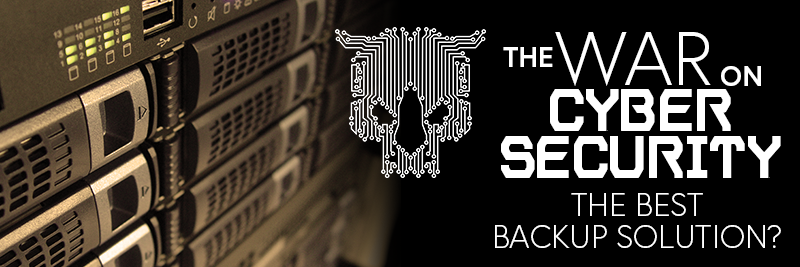
We have all heard horror stories of simple mistakes that lead to costly business disasters. Often, the damage is too great to overcome and the company that suffered the IT disaster can't recover from the incident. A simple power outage could put your whole business at risk. Planning for the unknown can be difficult and having the proper budget to implement a disaster recovery plan can seem daunting. However, it is a critical business need.
This is where having solid data backups comes into play.
Closing out this holiday season and going into 2020, it’s always the season for backups, and having up-to-date data backups can allow you to restore from a previous state before being infected by an online threat such a ransomware attack.
It's almost 2020. Do you know where your backups are?
We ask our clients this on a regular basis. With the combination of natural disasters, hardware failures, and human error, the reality is that data loss is only a matter of when, not if. Having a well-built and constantly maintained data backup process for your business is a necessity in today's technology-focused age.
Today, we are going to briefly define what are the three types of backup options widely available for business-grade data backups to help you determine what is the best solution for your business.

1. Local Physical Backups
Internal hard drives crash and wear down. A basic local data backup solution for a small business can be as simple as an external hard drive that you copy data to. Since they are portable and more lightweight, if you want to take your data with you when going on business trip, you can.
Just plug your external hard drive into another computer and you can pick up right where you left off, giving you greater control of who accesses your data. Also, since it is a physical drive, disconnecting it from the network helps to prevent malicious attacks from taking place.
However, the same sort of dangers with internal drives apply. Local external drives have a limited shelf life, and normal wear and tear will put any backups residing on these drives at risk over time. Local drives can also be quite costly depending on how much space you need, hardware upgrades, or software upgrades that may be necessary to accommodate them.
Not only that, a natural disaster could wipe out your backups on a local drive in an instant, potentially altering your drive to a state of irreversible repair.

2. Cloud Backups
A cloud backup (or Online Backup) is the process of backing up data to a remote, cloud-based server as a form of secured offsite data storage. It can either replace or complement currently used backup solutions in a business. Cloud data backup can be set up as a continuous, automatic on-demand process, incurring minimal data loss while maintaining accessibility for its users.
A major benefit of using cloud backups is that it makes managing backup systems easier. Most cloud backup providers allow you to set a backup schedule, operate with backup files, control allocated bandwidth, and add new files if needed with a high amount of scalability.
Another benefit to cloud backup services is that many cloud services providers (such as neoRhino) handle the upgrades and troubleshoot any problems that may occur. This provides greater automation and more time saving for the user since they do not have to micromanage their backups.
Perhaps most importantly, since cloud backups are reserved in an offsite location, a properly managed data backup is safe if a disaster occurs. If a hurricane strikes, a server fails, or a company is the victim of a ransomware attack, if they have a cloud backup solution, they can retrieve their sensitive data and restore from a previous state.
The main drawback to a cloud storage solution lies within accessibility. Since the data backups would be managed by a third-party provider, access to your files is at the availability of the service. If they have an outage or a security breach, your ability to retrieve your backups may be limited or even non-existent. This is one of the reasons we recommend the “3-2-1” backup rule. (link)
Cloud Backup or Cloud Storage?
Cloud backup should not be confused with cloud storage, which is typically a first thought when mentioning the cloud for data. Services such as OneDrive, Google Drive, and iCloud Backup are useful but are not the same as a true cloud-based data backup.
A cloud backup system serves as a remote site for storing data to be shared and accessed over the Internet, while Cloud Storage tends to be more focused on the preservation of single files, uploading when they need to be stored.
Cloud backups requires a much more continuous process, as it synchronizes data at the workstation with the data in the cloud, meaning that any changes in the original data will be reflected in its cloud version. Changes in your virtual infrastructure are updated in the cloud backup accordingly.
Meanwhile, cloud storage is meant more for backing up single files and is not always automatic, so the user may have to update the file in the cloud storage manually.

3. Hybrid Cloud Backups
Hybrid Cloud backups combine the abilities of public cloud, third-party private cloud, and on-premises data backups to create one well-managed hybrid solution to preserving your data.
The primary benefit of a hybrid cloud solution is versatility. The need to adapt and change direction quickly is a core principle of a business. The abilities of utilizing a hybrid cloud solution could bring greater flexibility and more options for data deployment. For example, your office’s data is contained in a private cloud while retaining the scalability of the public cloud, bringing heightened efficiency to your workforce.
What is the difference between Public Cloud and Private Cloud?
A public cloud is a computing service offered by third-party providers over the internet, making them available to anyone who wants to use or purchase them. Unlike private clouds, public clouds can save companies from the costs of having to purchase, manage, and maintain onsite hardware and application infrastructure. The cloud service provider is held responsible for the management and maintenance of the system. Public clouds can also be deployed faster than onsite infrastructures and with a near-infinite scalable platform.
Meanwhile, a Private Cloud is a cloud environment used by one organization exclusively and usually managed via internal resources or by a third-party vendor. They are typically designed for organizations that require more in-depth data control and a higher level of security. With a private cloud, end users experience the same ease of use offered in consuming resources from the public cloud, but from an internal platform. An effective private cloud will be able to deliver predictable performance and the ability to modify the performance on demand.
Although hybrid cloud users can experience cost savings over a long-term basis, the initial cost can be a larger investment than a Public Cloud solution due to the cost of the special hardware required for an on-premise solution to function. Hybrid Cloud solutions are also reliant on the local network infrastructure to function properly. If it is too slow, then the backup’s performance and reliability is affected.
If you’d like an even deeper look at how Backups work, our Tech Tips team discussed in detail about backups that you can watch here.
Don’t forget your Disaster Recovery Plan.
The goal of Disaster Recovery is to restore data and critical applications should your systems be affected during a crisis. A complete system crash, a data breach, relocation during a natural disaster, or even a coworker accidentally deleting a crucial file - all of these and more need to be considered when preparing a Disaster Recovery plan.
Backups serve to recover data after a loss, usually due to deletion or corruption, so it's crucial to have a strategy behind what you choose to backup and how you do it. A well-crafted Disaster Recovery plan should include backing up critical applications and data more completely and frequently than less essential data. Plus, many systems you currently use are likely cloud backed up already (such as Office 365 or Google Docs) and may not require additional backups.
We recommend having a detailed written policy where every application is backed up in a set schedule, ensuring it is encrypted, and is tested frequently. Click here for more information about our Disaster Recovery and Business Continuity Planning abilities.
No backup solution is foolproof.
Knowing the right course of action regarding your data can be the difference between success and failure for your company’s infrastructure. It is best to consult your IT provider or department to determine if a which backup solution is suitable for you. neoRhino’s Houston-based certified IT consultants and technicians will device the perfect backup solution for your business.
Fill out the form at the top of this page or you can Contact Us today for a FREE IT assessment. At neoRhino, we manage your technology so you can handle your business.



